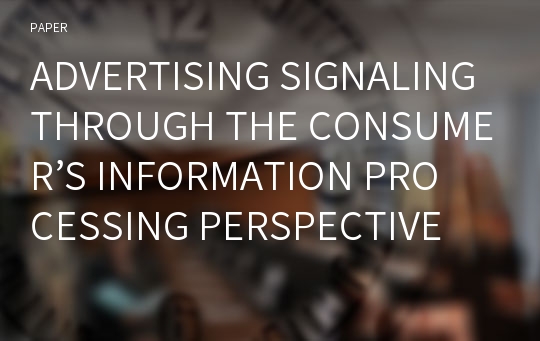ADVERTISING SIGNALING THROUGH THE CONSUMER’S INFORMATION PROCESSING PERSPECTIVE
* 본 문서는 배포용으로 복사 및 편집이 불가합니다.
서지정보
ㆍ발행기관 : 글로벌지식마케팅경영학회(GFMC)
ㆍ수록지정보 : Global Marketing Conference
ㆍ저자명 : Clara Isabel Koetz, Cristiane Pizzutti dos Santos, Gérard Cliquet
ㆍ저자명 : Clara Isabel Koetz, Cristiane Pizzutti dos Santos, Gérard Cliquet
영어 초록
Advertising signaling theory predicts that the amount that a company invests in advertising impacts on consumers’ perception about the quality of a product (Anand & Shachar, 2009). For this signaling to occur, some specific conditions are necessary, for example, the product must be a repetitive purchasing product and its quality must not be observable at the time of purchase, but only during the consumption of the product (Kirmani & Rao, 2000). Advertising signaling is based on the assumption of a rational consumer, who is expected to perform an objective and deliberate evaluation of the advertising actions, taking into account the amount invested by the company in the advertisement production and media and the level of investments applied by competitors in the same market to perceive the quality signals. However, this strictly rational perspective has been questioned since Simon (1947, 1955) demonstrated that humans’ rationality is limited by several factors, such as cognitive resources and selective memory, which may influence judgments and decision making. More recently, researchers have argued that affect is also a source of bounded rationality, playing an important role in the way people think and make decisions (e.g., Hanoch, 2002; Kaufman, 1999; Muramatsu & Hanoch, 2005). The objective of the present research is to examine advertising signaling theory through the consumer information processing perspective, exploring the influence of the following three variables on these processes: the individual’s mood, the level of information asymmetry about the product’s attributes and the individual’s gender. The study was applied to 390 undergraduate students in France. Three factors were manipulated in the study: the advertising investment, which was manipulated in three levels (below, the average and above the market average advertising investments for similar campaigns), the subject’s mood (two levels, positive and negative) and the level of information asymmetry about the product’s attributes (two levels, high information asymmetry and low information asymmetry). Thus, the research had a 3 x 2 x 2 experimental design. Respondents were asked to declare their gender, which was considered in a subsequent analysis. Students were approached in the university and invited to participate in the study. Twelve booklet models (each booklet contained the activities and scales related to one experimental group) were randomly distributed among the respondents who accepted to participate of the study. The results of an ANOVA analysis showed main effects of mood (F (1, 376) = 13.31, p < .001), level of information asymmetry (F (1, 376) = 135.00, p < .001) and advertising investment (F (2, 376) = 31.06, p< .001) on the respondents’ quality perception. These main effects were obtained in a context of two significant interactions, between the advertising investment and mood (F (2, 376) = 3.68, p < .050) and mood and information asymmetry about the product (F (1, 376) = 19.05, p < .001). Regarding the first significant interaction, the results showed that subjects who were informed that the advertising investment was below the market average showed similar means of product evaluation whether they were in a positive (M = 5.47) or negative (M = 5.46) mood (F (1, 364) = .000, p > .10). Those who were informed that the advertising investment was at the market average evaluated the product as significantly better when in a positive (M = 6.40) than a negative (M = 5.91) mood (F (1, 364) = 6.29, p < .05). In the same way, respondents who were informed that the advertising investment was above the market level evaluated the product as significantly better when they were in a positive (MPA = 6.94) than a negative (MNA = 6.19) mood (F (1, 364) = 14.32, p < .001). The interaction between the individual’s mood and the level of information asymmetry about the product demonstrated that subjects who were exposed to a slight level of information asymmetry, receiving some information about the product’s attributes, showed similar means of product evaluation whether they were in a positive (M = 6.71) or a negative (M = 6.74) mood (F (1, 364) = .04, p > .10). By contrast, those who were not given any information about the product characteristics, being exposed to a severe level of information asymmetry, evaluated the product as significantly better when in a positive (M = 5.83) than a negative (M = 4.96) mood (F (1, 364) = 27.63, p < .001). A second ANOVA model was conducted to examine the influence of the advertising investment and the individual’s gender on the perceived product quality. The results showed main effects of the advertising investment (F (2, 376) = 31.56, p < .001) and gender (F (1, 376) = 9.77, p < .005) on the subjects’ quality perception. These main effects were qualified by a significant interaction between the advertising investment and the subjects’ gender (F (2, 376) = 5.28, p < .010). Women evaluated the product quality as better (MW = 5.81) than men (MM = 4.71) in the context of advertising investments below the market average (F (1, 370) = 19.05, p < .001). This difference disappeared in the contexts of advertising investment at the market average (MW = 6.19, MM = 6.14, F (1, 370) = .04, p > .10) and above the market average (MW = 6.70, MM = 6.52, F (1, 370) = .55, p > .10), in which men and women showed similar means of perceived product quality. The results show that positive mood influences in the individuals’ perceived product quality specifically in situations of advertising investment at the market average and above the market average. When individuals were informed that a level of advertising below the market average was invested, they demonstrated similar means of product evaluation irrespective of their mood. By contrast, in situations in which they were informed that the company invested approximately the same as competitors in similar advertising campaigns, or even above this amount, respondents who were in a positive mood evaluated the product as significantly better than those who were in a negative mood. The fact that the advertising investment interacts with the individual’s mood suggests that both variables are likely processed by the same information processing route, namely, the peripheral route (Elaboration Likelihood Model, Petty, Cacioppo and Schumann, 1983). That is, although individuals are expected to compute the information related to the advertising investment through the central route, the signal emitted through the advertising investment is more likely processed by the peripheral route. Thus, this signal is also a heuristic element on which individuals based their product evaluations. Our findings also demonstrate gender differences in the processing of the information signaled through the advertising investment only in situations of advertising investment below the market average. In the contexts in which the advertising investment was manipulated below the market average, women evaluated the product as better than men. Nevertheless, in situations in which the advertising investments were manipulated at the market average and above the market average, men and women showed similar levels of perceived product quality. An explanation for this effect is that women are better able than men to process the information sent through the advertising investment and, thus, to perceive the advertising signal only at a specific level of advertising investment. Above a certain level of advertising investment, men are as motivated as women to process this information, causing the gender differences to disappear. This finding is consistent with the Selectivity Model (Meyers-Levy, 1989), which predicts that some situational elements may stimulate men and women to engage in an effortful and detailed processing of the information that can eliminate the differences between the genders. Thus, in situations in which the investment in advertising is sufficient to encourage both women and men to process it, the genders become equally sensitive to the advertising signaling.참고 자료
없음"Global Marketing Conference"의 다른 논문
 THE ROLES OF GREEN PACKAGING IN UGLY FOOD PURCHASE INTE..22페이지
THE ROLES OF GREEN PACKAGING IN UGLY FOOD PURCHASE INTE..22페이지 THE IMPACT OF INDUCED AWE ON ETHICAL TOURIST BEHAVIORS5페이지
THE IMPACT OF INDUCED AWE ON ETHICAL TOURIST BEHAVIORS5페이지 A BIBLIOMETRIC ANALYSIS OF SPIRITUAL TOURISM RESEARCH15페이지
A BIBLIOMETRIC ANALYSIS OF SPIRITUAL TOURISM RESEARCH15페이지 SOCIAL NETWORK ANALYSIS AND RESPONSE TIME TESTING: CONS..11페이지
SOCIAL NETWORK ANALYSIS AND RESPONSE TIME TESTING: CONS..11페이지 THE EFFECTS OF PARA-SOCIAL INTERACTION ON ONLINE CELEBR..3페이지
THE EFFECTS OF PARA-SOCIAL INTERACTION ON ONLINE CELEBR..3페이지 THE INFLUENCE OF OPINION LEADERS ON DAILY DEALS USER’S ..3페이지
THE INFLUENCE OF OPINION LEADERS ON DAILY DEALS USER’S ..3페이지 HOW IMMERSIVE RETAILING AFFECTS CONSUMERS’ URGE TO BUY:..6페이지
HOW IMMERSIVE RETAILING AFFECTS CONSUMERS’ URGE TO BUY:..6페이지 KEY TO SUPERSTARDOM IN A GLOBALISED MARKET: THE ROLE OF..6페이지
KEY TO SUPERSTARDOM IN A GLOBALISED MARKET: THE ROLE OF..6페이지 A POST-PANDEMIC LOOK AT TOURISTS’ PERCEIVED COOLNESS OF..4페이지
A POST-PANDEMIC LOOK AT TOURISTS’ PERCEIVED COOLNESS OF..4페이지 EXTRACTING OFFLINE RETAIL SHOPPING PATTERNS: OLLABORATI..5페이지
EXTRACTING OFFLINE RETAIL SHOPPING PATTERNS: OLLABORATI..5페이지




















